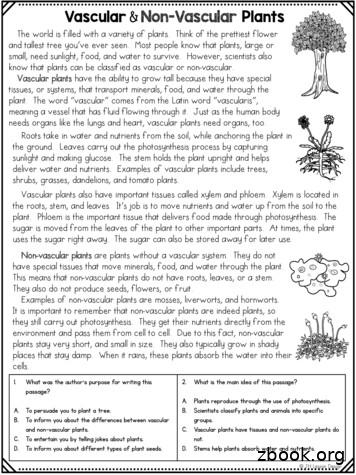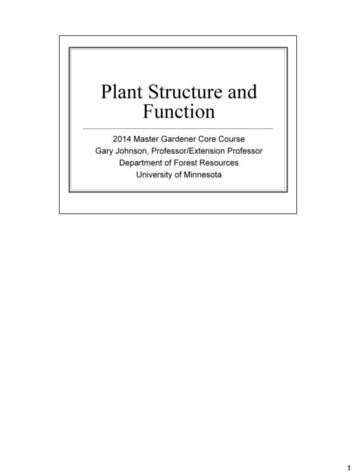Vascular Non-Vascular Plants - Third Grade
Vascular & Non-Vascular PlantsThe world is filled with a variety of plants. Think of the prettiest flowerand tallest tree you’ve ever seen. Most people know that plants, large orsmall, need sunlight, food, and water to survive. However, scientists alsoknow that plants can be classified as vascular or non-vascular.Vascular plants have the ability to grow tall because they have specialtissues, or systems, that transport minerals, food, and water through theplant. The word “vascular” comes from the Latin word “vascularis”,meaning a vessel that has fluid flowing through it. Just as the human bodyneeds organs like the lungs and heart, vascular plants need organs, too.Roots take in water and nutrients from the soil, while anchoring the plant inthe ground. Leaves carry out the photosynthesis process by capturingsunlight and making glucose. The stem holds the plant upright and helpsdeliver water and nutrients. Examples of vascular plants include trees,shrubs, grasses, dandelions, and tomato plants.Vascular plants also have important tissues called xylem and phloem. Xylem is located inthe roots, stem, and leaves. It’s job is to move nutrients and water up from the soil to theplant. Phloem is the important tissue that delivers food made through photosynthesis. Thesugar is moved from the leaves of the plant to other important parts. At times, the plantuses the sugar right away. The sugar can also be stored away for later use.Non-vascular plants are plants without a vascular system. They do nothave special tissues that move minerals, food, and water through the plant.This means that non-vascular plants do not have roots, leaves, or a stem.They also do not produce seeds, flowers, or fruit.Examples of non-vascular plants are mosses, liverworts, and hornworts.It is important to remember that non-vascular plants are indeed plants, sothey still carry out photosynthesis. They get their nutrients directly from theenvironment and pass them from cell to cell. Due to this fact, non-vascularplants stay very short, and small in size. They also typically grow in shadyplaces that stay damp. When it rains, these plants absorb the water into theircells.1.What was the author’s purpose for writing thispassage?A. To persuade you to plant a tree.B. To inform you about the differences between vascularand non-vascular plants.C. To entertain you by telling jokes about plants.D. To inform you about different types of plant seeds.2. What is the main idea of this passage?A. Plants reproduce through the use of photosynthesis.B. Scientists classify plants and animals into specificgroups.C. Vascular plants have tissues and non-vascular plants donot.D. Stems help plants absorb water and nutrients. JH Lesson Design
Name:Find the EvidenceDirections: Using the passage, find the text evidence for each question. Underline theevidence in the passage with the assigned color, then write your answer.What are vascular plants?List three examples of vascular plants:How are xylem and phloem different?How do non-vascular plants get nutrients?
Find the EvidenceDirections: Using the passage, find the text evidence for each question. Underline theevidence in the passage with the assigned color, then write your answer.What are vascular plants?Vascular plants have the ability to grow tallbecause they have special tissues, or systems,that transport minerals, food, and water throughthe plant.List three examples of vascular plants:Examples of vascular plants include trees,shrubs, grasses, dandelions, and tomato plants.How are xylem and phloem different?Xylem is located in the roots, stem, and leaves.It’s job is to move nutrients and water up from thesoil to the plant. Phloem is the important tissuethat delivers food made through photosynthesis.How do non-vascular plants get nutrients?They get their nutrients directly from theenvironment and pass them from cell to cell.
ANSWER Vascular & Non-Vascular PlantsKEYThe world is filled with a variety of plants. Think of the prettiest flowerand tallest tree you’ve ever seen. Most people know that plants, large orsmall, need sunlight, food, and water to survive. However, scientists alsoknow that plants can be classified as vascular or non-vascular.Vascular plants have the ability to grow tall because they have specialtissues, or systems, that transport minerals, food, and water through theplant. The word “vascular” comes from the Latin word “vascularis”,meaning a vessel that has fluid flowing through it. Just as the human bodyneeds organs like the lungs and heart, vascular plants need organs, too.Roots take in water and nutrients from the soil, while anchoring the plant inthe ground. Leaves carry out the photosynthesis process by capturingsunlight and making glucose. The stem holds the plant upright and helpsdeliver water and nutrients. Examples of vascular plants include trees,shrubs, grasses, dandelions, and tomato plants.Vascular plants also have important tissues called xylem and phloem. Xylem is located inthe roots, stem, and leaves. It’s job is to move nutrients and water up from the soil to theplant. Phloem is the important tissue that delivers food made through photosynthesis. Thesugar is moved from the leaves of the plant to other important parts. At times, the plantuses the sugar right away. The sugar can also be stored away for later use.Non-vascular plants are plants without a vascular system. They do nothave special tissues that move minerals, food, and water through the plant.This means that non-vascular plants do not have roots, leaves, or a stem.They also do not produce seeds, flowers, or fruit.Examples of non-vascular plants are mosses, liverworts, and hornworts.It is important to remember that non-vascular plants are indeed plants, sothey still carry out photosynthesis. They get their nutrients directly from theenvironment and pass them from cell to cell. Due to this fact, non-vascularplants stay very short, and small in size. They also typically grow in shadyplaces that stay damp. When it rains, these plants absorb the water into theircells.1.What was the author’s purpose for writing thispassage?A. To persuade you to plant a tree.B. To inform you about the differences between vascularand non-vascular plants.C. To entertain you by telling jokes about plants.D. To inform you about different types of plant seeds.2. What is the main idea of this passage?A. Plants reproduce through the use of photosynthesis.B. Scientists classify plants and animals into specificgroups.C. Vascular plants have tissues and non-vascular plants donot.D. Stems help plants absorb water and nutrients. JH Lesson Design
Interactive Notebook PageWrite facts, definitions, or examples from the passage under each flap.VascularPlantsNon-VascularPlants
VascularPlantsHow do they look?How do they getnutrients?Where are they found?
NonVascularPlantsHow do they look?How do they getnutrients?Where are they found?
Name:Vascular or Non-Vascular?Directions: Cut out the pictures on the next page. Decide if each picture is an example ofa vascular or non-vascular plant. Glue the picture in the correct larfernliverwortpincushiontree
Vascular or Non-Vascular?Directions: Cut out the pictures on the next page. Decide if each picture is an example ofa vascular or non-vascular plant. Glue the picture in the correct incushionhornwortliverwortmoss
Types of PlantsDirections: Glue the answer under thedescription.Moves nutrients up fromthe roots to the plant.Non-vascular plants growhere.Anchors vascular plants inthe groundHave special tissues totransport minerals.Do not have roots, stems,or leaves.Delivers food made fromphotosynthesis.PhloemVascular Plantsshady, damp areasXylemNon-Vascular Plantsroots
Types of PlantsDirections: Glue the answer under thedescription.Moves nutrients up fromthe roots to the plant.Non-vascular plants growhere.Xylemshady, damp areasAnchors vascular plants inthe groundHave special tissues totransport minerals.rootsVascular PlantsDo not have roots, stems,or leaves.Delivers food made fromphotosynthesis.Non-Vascular PlantsPhloem
Name:Compareand ContrastDirections: Write each fact on the Venn Diagram below.VascularNon-VascularUses photosynthesisGrow close to the groundHave roots, stems, and leavesHave xylem and phloemCan grow tallNo roots, stem, or leaves
Compareand ContrastDirections: Write each fact on the Venn Diagram below.VascularHave roots, stems,and leavesHave xylem and phloemCan grow tallNon-VascularGrow close to the groundUsesphotosynthesisNo roots, stem, or leaves
Thank You!Thank you so much for purchasing this product! Pleasereturn to my page after using this item to leavefeedback. This will not only help me know if this product isuseful, it will also help you earn credits to purchase futureitems!This product is intended to be used by the purchaser only.This purchase is intended for reproduction and use in asingle classroom only. Copying for more than one teacher,classroom, or department is prohibited, You may notpost this item anywhere to share with other teachers.Failure to comply is a copyright infringement and aviolation of the Digital Millennium Copyright Act (DMCA)Special Thanks to These Talented Sellers:
A. Plants reproduce through the use of photosynthesis. B. Scientists classify plants and animals into specific groups. C. Vascular plants have tissues and non-vascular plants do not. D. Stems help plants absorb water and nutrients. Directions: Using the passage
seedless vascular plants. 8. Plants with seeds are further divided into the two groups of gymnosperms and angiosperms. 28.2 Non-Vascular Plants Bryophytes 9. Give three examples of nonvascular plants: – Moss – Liverworts – Hornworts 28.3 Vascular Plants Tracheophytes 10.Classify each of the following as
plants Seedless vascular plants Gymnosperms Angiosperms Reproduction by spores Hardened vascular tissue Seeds Flowers Notice in Table 28-1 that vascular plants can be further divided into two groups, seedless plants and seed plants. Seedless plants include the phylum of ferns and three phyla made up of plants closely associated with ferns.
20. List examples of: vascular plants. 21. Why are they called vascular plants? 22. During alternation of generation of vascular plants is the gametophyte or sporophyte predominant? 23. Define waxy cuticle and stomate. 24. Vascular plants are divided into which two main groups? 25. List some examples of
3/1/2011 6 Diverged prior to the origin of seeds Seedless vascular plants Lycophytes, pteridophytes and seed-producing plants are vascular plants or 21 producing plants are vascular plants or tracheophytes Possess tracheids for water and mineral conduction and structural support
(nonvascular plants) Seedless vascular plants Seed plants Vascular plants Land plants . The general groups of seedless vascular plants . 2 Phylum Lycophyta: Club Mosses, Spike Mosses, and Quillworts . No two Pla
Topic 22. Introduction to Vascular Plants: The Lycophytes Introduction to Vascular Plants Other than liverworts, hornworts, and mosses, all plants have vascular tissues. As discussed earlier, the mosses have cells that serve to conduct water and photosynthate, and these cell
that allow plants to live, grow and reproduce. Discussions of structure will be primarily morphological, that is, the gross structure of plants. . Non-vascular plants is a general term for those plants without a vascular system (xylem and phloem). . flowering plants) can be further classified as either monocotyledonous or
15th AMC ! 8 1999 5 Problems 17, 18, and 19 refer to the following: Cookies For a Crowd At Central Middle School the 108 students who take the AMC! 8 meet in the evening to talk about prob-lems and eat an average of two cookies apiece. Walter and Gretel are baking Bonnie’s Best Bar Cookies this year. Their recipe, which makes a pan of 15 cookies, list these items: 11 2 cups of our, 2 eggs .























